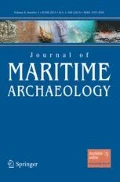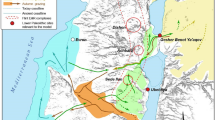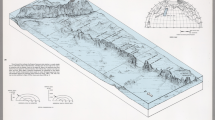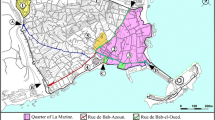Abstract
Across the Caribbean and adjacent regions, systematic inventories of historical ship graffiti remain markedly incomplete. Previous studies had identified several islands in the Bahamas and Turks and Caicos associated with ship graffiti primarily within colonial period structures. We expanded the range of these preliminary inventories, recording a diverse array of ship graffiti specific to plantation era structures across seven islands in the Bahamian Archipelago, as well as the sole cave site known to harbor such imagery. Examples were also associated with Spanish colonial era fortifications in Old San Juan and found within a set of nine of the numerous caves found on Isla de Mona and two caves on the Puerto Rican mainland. Many of the nautical images encountered were previously unrecorded as they have only recently been revealed through systematic exploration and detailed site surveys, demonstrating that the phenomenon is regionally more widespread and complex than previously known. In this interregional study of ship graffiti in the Puerto Rican and Bahamian Archipelagos, we examine image distribution patterns, techniques, preservation status and historical context unique to each area, contrasting the respective Euro-colonial cultural arcs reflected in these distinctive nautical iconographies. Although each act of mark-making is historically and contextually unique, we consider what this imagery has in common, namely that the majority were produced under conditions of slavery, confinement, and/or hard labor.





















Similar content being viewed by others
References
Abbas Shatto RC (1998) Maritime trade and seafaring of the Pre-Columbian Maya, MA Thesis. Department of Anthropology, Texas A&M University
Archivo Histórico Nacional [AHN] (1851) Sobre descubrimiento y explotación de guano en las Islas Mona y Monito. ULTRAMAR 389, San Juan, PR
Armentrout DL, Panuska BC (1995) Preliminary minimum age constraints on a vertebrate fossil bearing cave, Isla de Mona, Puerto Rico. Geol Soc Am Abstr Programs 27(6):A-345
Bahn PG (2010) Prehistoric rock art: polemics and progress. Cambridge University Press, New York
Baxter JE (2010) Casting children as cultural actors in archaeological interpretations: A case study of graffiti from 19th century San Salvador, The Bahamas. Complutum 21(2):181–196
Baxter JE (2011) Creating community on 19th century San Salvador: ship graffiti and identity in the Bahamian past. In: Baxter JE, Cole ES (eds), Proceedings of the thirteenth annual symposium on the natural history of the Bahamas, Gerace Research Centre, San Salvador, pp 238–251
Baxter JE, Burton J (2006) Building meaning into the landscape: building design and use at Polly Hill Plantation, San Salvador, Bahamas. J Bahamas Hist Soc 28:35–44
Bayliss-Smith T, Mulk I-M (1999) Sailing boats in Padjelanta: Sámi rock engravings from the mountains in Laponia, northern Sweden. Acta Borealia 16(1):3–41
Behrmann R, Ramirez PB, Antón RG, del Arco Aguilar C (eds) (2009) Grabados rupestres de la fachada Atlántica Europea y Africana: Rock carvings of the European and African Atlantic façade. BAR international series 2043, Archaeopress, Oxford
Brooker C (2006) Preliminary historical and architectural investigation of abandoned settlements at Alexandria and Lantern Head, Great Abaco Island, the Bahamas. Report submitted to Islands by Design, Nassau
Brusi y Font J (1884) Viaje a la Isla de la Mona: Para inteligencia de todos y escarmiento de muchos. Tipografía Comercial, Mayaguez
Burton JD (2005) The demographics of slavery: sandy point plantation and the Prince Storr murder case. In: Proceedings of the 10th symposium of the natural history of the Bahamas, Gerace Research Centre, San Salvador, pp 1–11
Casado Soto JL (2001) The Spanish ships of the oceanic expansion: Documentation, archaeology and iconography from the 15th and 16th Centuries. In: Proceedings of the international symposium on archaeology of medieval and modern ships of Iberian-Atlantic Tradition (1998), Instituto Portugués de Arqueologia, Lisboa, pp 131–161
Champion M (2015) Medieval ship graffiti in English churches: interpretation and function. The Mariner’s Mirror 101:343–350
Clarke A, Frederick U (2006) Closing the distance: interpreting cross-cultural engagements through indigenous rock art. In: Lilley I (ed) Archaeology of Oceania: Australia and the Pacific islands. Blackwell Publishing, Oxford, pp 116–133
Cooper JE, Samson AVM, Nieves MA, Lace MJ, Caamano-Dones J, Cartwright C, Kambesis PN, Frese L (2016) ‘The Mona chronicle’: the archaeology of early religious encounter in the new world. Antiquity 90:1054–1071
Craton M (2009) Testing the chains: resistance to slavery in the British West Indies. Cornell University Press, Ithaca
Crumlin-Pedersen O, Munch Thye B (1995) The ship as symbol in prehistoric and medieval Scandinavia. Papers from an international research seminar at the Danish National Museum, Copenhagen, 5th–7th May 1994, National Museum of Denmark, Department of Archaeology and Early History, Copenhagen
Curet LA, Hauser MW (2011) Islands at the crossroads: Migration, seafaring, and interaction in the Caribbean. University of Alabama Press, Tuscaloosa
Dávila O (2003) Arqueologia de la Isla de la Mona. Editorial del Instituto de Cultura Puertorriqueña, San Juan
Farnsworth P (1993) Archaeological excavations at Wade’s Green Plantation, North Caicos. J Bahamas Hist Soc 15(1):2–10
Farnsworth P (2000) Brutality or benevolence in plantation archaeology. Int J Hist Archaeol 4(2):145–158
Farnsworth P, Wilkie L (1995) Crooked Island. Afr Diaspora Archaeol Newsl 2(3):9
Farr H (2006) Seafaring as social action. J Marit Archaeol 1(1):85–99
Fitzpatrick SM (2013) Seafaring capabilities in the pre-Columbian Caribbean. J Marit Archaeol 8(1):101–138
Frederick U, Clarke A (2014) Signs of the times: archaeological approaches to historical and contemporary graffiti. Austr Archaeol 78(1):54–57
Gillespie AR, Kahle AB, Walker RE (1986) Color enhancement of highly correlated images. I. Decorrelation and HSI contrast stretches. Rem Sens Environ 20(3):209–235
González Gozalo E (2017) Nautical graffiti in Mallorca. Int J Nautical Archaeol 46(2):437–448
Goodland EA (1979) Schomburgk’s ships. New West Indian Guide 53(3/4):141–146
Hall TI, Gordon C (eds) (1899) The Navassa Island riot. The American Job Office, Baltimore
Harris L (2014) From African canoe to plantation crew: tracing maritime memory and legacy. Interdiscip J Marit Stud 4(2):35–52
Hatch HE (2013) Harbour Island: the comparative archaeology of a maritime community. Dissertation, Texas A&M University
Hauser MW, Armstrong DV (2012) The archaeology of not being governed: a counterpoint to a history of settlement of two colonies in the eastern Caribbean. J Soc Archaeol 12:310–333
Kaul F (1998) Ships on bronzes: a study in bronze age religion and iconography: catalogue of Danish finds. II. National Museum of Denmark, Department of Danish Collections, Copenhagen
Keith DH (2016) A phantasmal project: saving the ghost fleet of the Caicos Islands. Times of the Islands 116:54–58
Kennedy CM (2007) The other white gold: salt, slaves, the Turks and Caicos Islands, and British colonialism. Historian 69(2):215–230
Kennedy N (2013) Bahamas, Bermuda and the Turks and Caicos Islands. In: Pope PE, Lewis-Simpson S (eds) Exploring atlantic transitions: archaeologies of transience and permanence in New Found Lands. Boydell Press, Woodbridge, pp 80–92
Kozy CJ (1991) Tories transplanted: the Caribbean exile and plantation settlement of southern Loyalists. Georgia Hist Q 75(1):18–42
Lace MJ (2012) Anthropogenic use, modification and preservation of coastal caves in Puerto Rico. J Island Coast Archaeol 7(3):1–25
Lace MJ (2014) Advances in the exploration and management of coastal karst in the Caribbean. In: Finkl C, Makowski C (eds) Advances in coastal and marine resources: environmental management and governance, vol 8. Coastal Research Library Series. Springer, Dordecht, pp 143–172
Lace MJ, Mylroie JE (2013) Coastal cave and karst resource management. In: Lace MJ, Mylroie JE (eds) Coastal karst landforms. Springer, Dordecht, pp 127–143
Lace MJ, Kambesis PN, Mylroie JE (2016a) Sistema Faro, Isla de Mona, Puerto Rico: speleogenesis of the world’s longest flank margin cave. In: Robledo PA, Duran JJ (eds). Large cave systems of the world. Boletín Geológico y Minero 127(1): 205–217
Lace MJ, Mylroie JE, Albury NA, Mylroie JR (2016b) The Coastal Cave Survey summary report on the caves of the Turks and Caicos reconnaissance expedition December 6–20, 2015. Report submitted to the Department of Environmental and Maritime Affairs, Turks and Caicos Islands
Lace MJ, Mylroie JE, Mylroie JR, Albury NA (2018) The rock art of Bahamian caves: multi-scalar distribution patterns and preservation management. J Caribb Archaeol 18:70–103
Lance M, Carr RS (2003) Interim report on archaeological investigation at New Plymouth, Green Turtle Cay Abaco, The Bahamas. Report to the Albert Lowe Museum from the Archaeological and Historical Conservancy, Inc. Davie, FL
Lape PV, O’Connor S, Burmingham N (2007) Rock art: a potential source of information about past maritime technology in the South-East Asia-Pacific Region. Int J Naut Archaeol 36(2):238–253
Lofquist WS (2010) Executions in the Bahamas. Int J Bahamian Stud 16:19–34
Lopez Belando A (2011) El arte rupestre en el Parque Nacional Los Haitises. http://rupestreweb.info/haitises2.html. Accessed 1 Aug 2018
Maarveld TJ (1995) Type or technique: some thoughts on boat and ship finds as indicative of cultural traditions. Int J Naut Archaeol 24(1):3–7
May SK, Taçon PS, Wesley D, Pearson M (2013) Painted ships on a painted Arnhem Land landscape. J Austr Assoc Marit Res 35(2):83–102
Meyers A, Shaw A (2015) The Cat Island heritage project. Soc Hist Archaeol Newsl 48(1):26–28
Michail M (2015) Ship graffiti in context: a preliminary study of Cypriot patterns. In: Hadjikyriakos I, Trentin MG (eds), Cypriot cultural details: proceedings of the 10th annual meeting of young researchers in Cypriot archaeology, Oxford Books, Philadelphia, pp 41–64
Mylroie JE, Mylroie JR (2013) Caves and karst of the Bahama Islands. In: Lace MJ, Mylroie JE (eds) Coastal karst landforms. Springer, Dordecht, pp 147–176
Palmer R (2016) Religious colonialism in early modern Malta: inquisitorial imprisonment and inmate graffiti. Int J Hist Archaeol 20(3):548–561
Pollard E, Bita C (2017) Ship engravings at Kilepwa, Mida Creek, Kenya. Azania Archaeol Res Afr 52(2):173–191
Quinlan A (2007) Integrating rock art with archaeology: symbolic cultures as archaeology. In: Quinlan A (ed) Great Basin rock art. University of Nevada Press, Reno
Rivera-Collazo IC (2006) Historical ship graffiti on the walls of San Juan’s Spanish defense system: an interim report. Int J Naut Archaeol 35(1):41–52
Rodriguez Ramos R (2017) La temporalidad absoluta del arte rupestre pictográfico en Puerto Rico. Report prepared for La Oficina Estatal de Conservación Histórica, San Juan, Puerto Rico
Samson AVM, Cooper JE (2015) History on Mona: long-term human and landscape dynamics of an “uninhabited island”. New West Indian Guide 89:30–66
Samson AVM, Cooper JE, Nieves MA, Rodríguez Ramos R, Kambesis PN, Lace MJ (2013) Cavescapes in the Pre-Columbian Caribbean. Antiquity 87(338):1–7
Samson AVM, Wrapson LJ, Cartwright CR, Sahy D, Stacey RJ, Cooper JE (2017) Artists before Columbus: a multi-method characterization of the materials and practices of Caribbean cave art. J Archaeol Sci 88:24–36
Sapwell M, Janik L (2015) Making community: Rock art and the creative acts of accumulation. In: Berge R, Lingaard E, Stuedal HV, Steberglokken H (eds) Ritual landscapes and borders within rock art research. Archaeopress, Oxford, pp 47–58
Schomburgk R (1840) Journey from Esmeralda, on the Orinoco, to San Carlos and Moura on the Rio Negro, and thence by Fort San Joaquim to Demerara, in the spring of 1839. J R Geogr Soc Lond 10:248–267
Schomburgk R (1854) Ethnological researches in Santo Domingo. J Ethnol Soc Lond 1848–1856(3):115–122
Schroedl GF, Ahlman T (2002) The maintenance of cultural and personal identities of enslaved Africans and British soldiers at the Brimstone Hill Fortress, St. Kitts, West Indies. Hist Archaeol 36(4):38–49
Sukkham A, Taçon PS, Tan NH, Muhamad AB (2017) Ships and maritime activities in the North-eastern Indian Ocean: re-analysis of rock art of Tham Phrayanaga (Viking Cave), Southern Thailand. Int J Naut Archaeol 46(1):108–131
Taçon PS, May SK (2013) Ship shape: an exploration of maritime-related depictions in indigenous rock art and material culture. J Austr Assoc Marit Res 35(2):7–15
Tripathi A (2006) Antiquity of sailing ships of the Indian Ocean: evidence from ancient Indian art. Ziff J 3:25–34
Turner GSR (2004) Bahamian ship graffiti, MA Thesis, Department of Anthropology, Texas A&M University
Turner GSR (2006) Bahamian ship graffiti. Int J Naut Archaeol 35(2):253–273
Vieten R, Winter A, Samson AVM, Cooper J, Wrapson L, Kambesis P, Lace MJ, Nieves MA (2016) Quantifying the impact of human visitation in two cave chambers on Mona Island (Puerto Rico): implications for archaeological site conservation. J Cave Karst Stud 43(2):79–85
Wadsworth FH (1973) The historical resources of Mona Island. In: Junta de Calidad Ambiental de Puerto Rico, Isla Mona, 2: N: 1–37
Wesley D, McKinnon JF, Raupp JT (2012) Sails set in stone: a technological analysis of non-Indigenous watercraft rock art paintings in North Western Arnhem Land. J Marit Archaeol 7(2):245–269
Wilkie LA (2001) Communicative bridges linking actors through time: archaeology and the construction of emancipatory narratives at a Bahamian plantation. J Soc Archaeol 1(2):225–243
Wilkie LA, Farnsworth P (1999) Trade and the construction of Bahamian identity: a multiscalar exploration. Int J Hist Archaeol 3(4):283–320
Woolner D (1957) Graffiti of ships at Tarxien, Malta. Antiquity 31(122):60–67
Acknowledgements
The authors wish to thank the Antiquities, Monuments and Museum Corporation (AMMC) and Bahamas Environment, Science and Technology (BEST) Commission, Ministry of the Environment, Commonwealth of the Bahamas, the Department of the Environment and Coastal Affairs (DECA) of the Turks and Caicos Islands, the Puerto Rico Departmento Recursos Naturales y Ambientales (DRNA) and the Oficina Estatal de Conservación Histórica (Puerto Rico) for their support of cave research conducted in the respective study areas. The authors also wish to thank U.S. National Park Service resource managers for access to the respective colonial structures in Puerto Rico and the U.S. Virgin Islands and to Grace Turner, John Mylroie, Joan Mylroie and Michael Albury for their assistance in the field.
Funding
Partial funding for this study was provided by the National Geographic Society and the Oficina Estatal de Conservación Histórica (Puerto Rico)
Author information
Authors and Affiliations
Corresponding author
Ethics declarations
Conflict of interest
The authors declare they have no conflict of interest.
Ethical standards
The authors confirm that this original work is not under consideration for publication in any other forum and that it complies with all ethical standards.
Additional information
Publisher's Note
Springer Nature remains neutral with regard to jurisdictional claims in published maps and institutional affiliations.
Rights and permissions
About this article
Cite this article
Lace, M.J., Albury, N.A., Samson, A.V.M. et al. Ship Graffiti on the Islands of the Bahamas, Turks and Caicos and Puerto Rico: A Comparative Analysis. J Mari Arch 14, 239–271 (2019). https://doi.org/10.1007/s11457-019-09228-x
Published:
Issue Date:
DOI: https://doi.org/10.1007/s11457-019-09228-x




